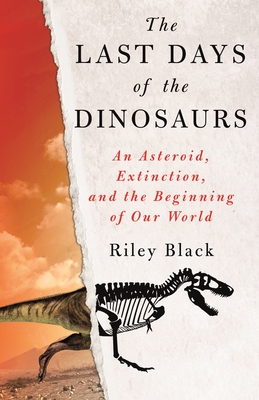Rama Rao's Reviews > The Last Days of the Dinosaurs: An Asteroid, Extinction, and the Beginning of Our World
The Last Days of the Dinosaurs: An Asteroid, Extinction, and the Beginning of Our World
by

by

Rama Rao's review
bookshelves: ancient-history, biology, ecology, evolution, science, united-states, non-fiction, earth
Sep 18, 2022
bookshelves: ancient-history, biology, ecology, evolution, science, united-states, non-fiction, earth
The day dinosaurs died
The last day of the dinosaurs began as any morning during the Spring season 66.043 million years ago in the Northwestern states of the Unted States. Tanis is part of the heavily studied Hell Creek Formation, a group of rocks spanning four states renowned for significant fossil discoveries from the Upper Cretaceous (Cretaceous era;100.5–66 million years ago) and lower Paleocene (Paleocene era; 66-56 million years ago). Tanis is a significant site because it recorded the events 15 minutes after the impact of the giant seven-mile-wide Chicxulub asteroid in palaeobiological detail. This impact which struck the Gulf of Mexico wiped out all non-avian dinosaurs.
Tanis resides in the state of North Dakota about 2,000 miles from the impact site in the Gulf of Mexico. The globe burned with wildfires, earthquakes, tsunamis, and seismic waves ravaged life at Tanis. The life at Tanis was entombed in sediment by seismic waves that was travelling at 11,000 miles per hour. These fossils were recently discovered and first reported in New Yorker Magazine in March 2019. The fossils of sturgeon and paddlefish hold the key which had small particles stuck in their gills. These are the glass spherules of molten rock kicked out from the impact site in the Gulf of Mexico that then fell back across the planet. The Tanis fishes breathed these particles as they were thrown out of the river as the big surge dismantled and disoriented the entire ecosystem with tens of miles on the land from the river. On this Earth-shattering day, sulfur ejected by the asteroid blocked all sunlight. The atmosphere turned acidic due to sulfuric acid and the oceans became unhabitable. The planet was plunged into darkness for decades, and temperatures dropped dramatically.
The Western Interior Seaway was a large inland sea that existed from the early Late Cretaceous to earliest Paleocene, splitting the continent of North America into two landmasses, Laramidia to the west and Appalachia to the east. Tanis in North Dakota was the northern end of the seaway where the catastrophic events occurred.
The author is a well-known journalist covering the paleontological significance of the death and destruction caused on the same day of the asteroid impact. There are numerous blogs and even discussions on TV about fossil evidence on the last day of the dinosaur. This book reads effortlessly despite the lack of illustrations and photographs in this book. Parts of book material has already appeared in Smithsonian Magazine.
The last day of the dinosaurs began as any morning during the Spring season 66.043 million years ago in the Northwestern states of the Unted States. Tanis is part of the heavily studied Hell Creek Formation, a group of rocks spanning four states renowned for significant fossil discoveries from the Upper Cretaceous (Cretaceous era;100.5–66 million years ago) and lower Paleocene (Paleocene era; 66-56 million years ago). Tanis is a significant site because it recorded the events 15 minutes after the impact of the giant seven-mile-wide Chicxulub asteroid in palaeobiological detail. This impact which struck the Gulf of Mexico wiped out all non-avian dinosaurs.
Tanis resides in the state of North Dakota about 2,000 miles from the impact site in the Gulf of Mexico. The globe burned with wildfires, earthquakes, tsunamis, and seismic waves ravaged life at Tanis. The life at Tanis was entombed in sediment by seismic waves that was travelling at 11,000 miles per hour. These fossils were recently discovered and first reported in New Yorker Magazine in March 2019. The fossils of sturgeon and paddlefish hold the key which had small particles stuck in their gills. These are the glass spherules of molten rock kicked out from the impact site in the Gulf of Mexico that then fell back across the planet. The Tanis fishes breathed these particles as they were thrown out of the river as the big surge dismantled and disoriented the entire ecosystem with tens of miles on the land from the river. On this Earth-shattering day, sulfur ejected by the asteroid blocked all sunlight. The atmosphere turned acidic due to sulfuric acid and the oceans became unhabitable. The planet was plunged into darkness for decades, and temperatures dropped dramatically.
The Western Interior Seaway was a large inland sea that existed from the early Late Cretaceous to earliest Paleocene, splitting the continent of North America into two landmasses, Laramidia to the west and Appalachia to the east. Tanis in North Dakota was the northern end of the seaway where the catastrophic events occurred.
The author is a well-known journalist covering the paleontological significance of the death and destruction caused on the same day of the asteroid impact. There are numerous blogs and even discussions on TV about fossil evidence on the last day of the dinosaur. This book reads effortlessly despite the lack of illustrations and photographs in this book. Parts of book material has already appeared in Smithsonian Magazine.
Sign into Goodreads to see if any of your friends have read
The Last Days of the Dinosaurs.
Sign In »
Reading Progress
September 1, 2022
–
Started Reading
September 18, 2022
– Shelved
September 18, 2022
– Shelved as:
ancient-history
September 18, 2022
– Shelved as:
biology
September 18, 2022
– Shelved as:
ecology
September 18, 2022
– Shelved as:
evolution
September 18, 2022
– Shelved as:
science
September 18, 2022
– Shelved as:
united-states
September 18, 2022
– Shelved as:
non-fiction
September 18, 2022
– Shelved as:
earth
September 18, 2022
–
Finished Reading


